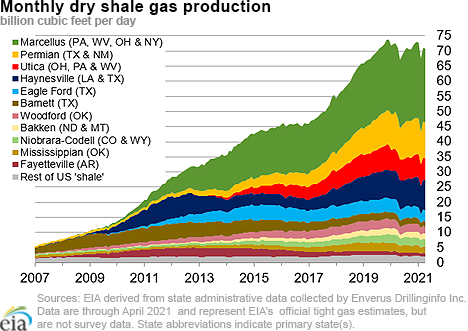In the News:
Dry natural gas production continues to grow from pandemic lows as rig count also increases
Our May Short-Term Energy Outlook (STEO) forecasts May 2021 dry production will average 90.8 billion cubic feet per day (Bcf/d), compared with 87.8 Bcf/d in May 2020. The record-high production level for U.S. natural gas was set in December 2019 when dry production hit an average of 97.0 Bcf/d, which was 9.2 Bcf/d higher than May 2020 levels. Except for February 2021, when weather-related well freeze-offs contributed to natural gas production shut ins, May 2020 was the low point for natural gas production so far during the pandemic as COVID-19 mitigation efforts and warmer weather resulted in diminished natural gas demand and lower prices. We expect dry natural gas production to continue to grow through the end of 2022, averaging about 94.4 Bcf/d in November and December of 2022, which is still more than 2.5 Bcf/d below December 2019.
Increased drilling activity is partially responsible for the increase in natural gas production. The number of active drilling rigs in the United States fell to 244 in August 2020, the lowest level since at least 1987, according to data from Baker Hughes Company. The rig count is gradually recovering, and as of May 11, the reported total number of active rigs in the United States was 453, and 100 of those active rigs were directed at drilling for natural gas (compared with a low of 68 in July 2020). Oil-directed activity also results in increased natural gas production because associated natural gas production rises in response to recovery in oil production.
The U.S. plays that are focused on producing natural gas are the Marcellus and Utica formations in the Appalachia Basin and the Haynesville formation in the North Louisiana Salt Basin of northeast Texas and northwest Louisiana. The current rebound in active natural gas rigs has occurred primarily in the Haynesville formation, whose proximity to liquefied natural gas export terminals and industrial demand along the Gulf Coast has supported demand for natural gas production from the Haynesville. The number of active natural gas rigs in the Haynesville as of May 11 (47 rigs) has returned to nearly the same level as the same week in May 2019 (50 rigs). Drillers have increased natural gas rig activity somewhat from 2020 lows in other formations, but they have not returned to 2019 levels.
Overview:
(For the week ending Wednesday, May 19, 2021)
- Natural gas spot price movements were mixed this report week (Wednesday, May 12 to Wednesday, May 19). The Henry Hub spot price fell from $2.90 per million British thermal units (MMBtu) last Wednesday to $2.88/MMBtu yesterday.
- The price of the June 2021 NYMEX contract was unchanged Wednesday to Wednesday at $2.964/MMBtu. The price of the 12-month strip averaging June 2021 through May 2022 futures contracts climbed 2¢/MMBtu to $3.025/MMBtu.
- The net injections to working gas totaled 71 billion cubic feet (Bcf) for the week ending May 14. Working natural gas stocks totaled 2,100 Bcf, which is 16% lower than the year-ago level and 4% lower than the five-year (2016–2020) average for this week.
- The natural gas plant liquids composite price at Mont Belvieu, Texas, rose by 12¢/MMBtu, averaging $7.61/MMBtu for the week ending May 19. The price of ethane rose 3% week over week, as robust domestic petrochemical activity and increased pace of loadings at Gulf Coast export terminals increase total demand to what we estimate will be the highest levels to date. Prices of propane rose 1% week over week, reflecting a relatively flat market for this time of year. EPA’s waiver of gasoline RVP limits related to the Colonial Pipeline shutdown remained in place through May 18, allowing for higher blending of butanes into motor gasoline and for average week-on-week prices of normal butane and isobutane to rise by 4%, and 3%, respectively. The price of natural gasoline fell by 1%, following the Brent crude oil price, which also declined 1% week over week.
- According to Baker Hughes, for the week ending Tuesday, May 11, the natural gas rig count decreased by 3 to 100, losing some of the gain from last week, when Baker Hughes reported a 7-rig increase. The number of oil-directed rigs rose by 8 to 352; the largest gains in oil-directed rigs were reported for Louisiana, where Baker Hughes reported a 3-rig increase in the offshore. The total rig count increased by 5, and it now stands at 453.
Prices/Supply/Demand:
Natural gas prices mixed as weather across the country shifts from below- to above-normal during this shoulder season. This report week (Wednesday, May 12 to Wednesday, May 19), the Henry Hub spot price fell 2¢ from $2.90/MMBtu last Wednesday to $2.88/MMBtu yesterday. The natural gas market was fairly balanced this week, with declines in both exports to Mexico and liquefied natural gas (LNG) feedgas largely offset by lower imports from Canada.
Midwest prices hold steady week over week, as demand for space heating declines and power generation demand for air conditioning increases. At the Chicago Citygate, the price was unchanged from last Wednesday at $2.80/MMBtu. The Natural Gas Intelligence Midwest Regional Average was also steady, increasing 1¢ from $2.76/MMBtu last Wednesday to $2.77/MMBtu yesterday. Both prices reached a weekly high on Monday, at $2.87/MMBtu and $2.86/MMBtu, respectively. IHS Markit reports a rapid shift in Midwest natural gas demand early this week, with consumption for power generation rising 36% from Sunday to Tuesday and residential/commercial demand also declining by 36%. Temperatures reported for Des Moines, Iowa, during this period rose from an average of 57ºF on Sunday, 5ºF below normal, to 64ºF, 1ºF above normal, on Tuesday.
Prices in California decline as demand falls and maintenance at the Aliso Canyon storage facility continues. The price at PG&E Citygate in Northern California fell 11¢, down from $4.07/MMBtu last Wednesday to $3.96/MMBtu yesterday, after reaching a weekly high of $4.11/MMBtu on Monday, reflecting price declines in the supply regions. Temperatures across the West were moderate throughout the week, resulting in lower prices in most markets supplying natural gas to the Pacific Gas & Electric (PG&E) territory. Prices at Malin, Oregon, on the Oregon-California border, declined 7¢ from $2.88/MMBtu last Wednesday to $2.81/MMBtu yesterday. Prices at Opal, Wyoming, the main trading point for natural gas in the Rocky Mountain region and the origin point for deliveries into the California market through the Ruby Pipeline, fell 6¢ from $2.82/MMBtu last Wednesday to $2.76/MMBtu yesterday.
The price at SoCal Citygate in Southern California decreased 15¢ from $3.39/MMBtu last Wednesday to $3.24/MMBtu yesterday, after falling as low as $2.89/MMBtu on Friday. SoCalGas reports continuing maintenance at the Aliso Canyon storage facility. Maintenance at Aliso Canyon, Southern California’s largest natural gas storage facility, has reduced access to storage during the injection season by 545 million cubic feet per day (MMcf/d). The outage began on May 9 and will last through May 24. SoCalGas also reports smaller maintenance-related impairments to natural gas injection capacity at the Goleta, Honor Rancho, and Playa del Ray storage fields, which together further reduce injection capacity by another 170 MMcf/d. The ability to inject gas into storage caverns would have provided an outlet for excess natural gas volumes to balance the market if these storage fields were not under maintenance.
Prices in the Northeast rise as temperatures and air conditioning demand increase, increasing demand for natural gas for power generation. IHS Markit reports natural gas deliveries to power generators in the region were 2.3 billion cubic feet per day (Bcf/d) higher yesterday than last Wednesday. Rapid changes in temperature may result in market dislocation as demand shifts from one market segment to another. Daily high temperatures in Boston were in the mid-70s on Saturday through Monday, and rose to 84ºF on Tuesday. At the Algonquin Citygate, which serves Boston-area consumers, the price went up 17¢ from $2.29/MMBtu last Wednesday to $2.46/MMBtu yesterday, after reaching a weekly high of $2.93/MMBtu on Monday. Temperatures in New York also rose rapidly, reaching a daily high of 86ºF yesterday, 14ºF above normal. At the Transcontinental Pipeline Zone 6 trading point for New York City, the price increased 23¢ from $2.25/MMBtu last Wednesday to $2.48/MMBtu yesterday.
Prices in the Appalachian Basin production region rise along with prices in the Midwest and Northeast consuming regions. The Tennessee Zone 4 Marcellus spot price increased 31¢ from $1.70/MMBtu last Wednesday to $2.01/MMBtu yesterday, after reaching a weekly high of $2.24/MMBtu on Tuesday. The price at Dominion South in southwest Pennsylvania rose 10¢ from $2.19/MMBtu last Wednesday to $2.29/MMBtu yesterday, after rising to $2.33/MMBtu on Monday.
Prices in the Permian Basin production region continue to rise, decreasing the discount to the Henry Hub. The price at the Waha Hub in West Texas, which is located near Permian Basin production activities, rose 4¢, from $2.72/MMBtu last Wednesday to $2.76/MMBtu yesterday. The discount at Waha relative to the Henry Hub price continues to decline. The discount was 12¢/MMBtu yesterday, 18¢/MMBtu last Wednesday, and 28¢/MMBtu the Wednesday before that.
U.S. production of natural gas flat week over week. According to data from IHS Markit, the average total supply of natural gas fell slightly by 0.3% compared with the previous report week. Dry natural gas production remained unchanged week over week. Average net imports from Canada decreased by 6.2% from last week.
Demand declines on lower heating consumption in the residential and commercial sector and reduced export volumes. Total U.S. natural gas demand fell by 10.8% compared with the previous report week, according to data from IHS Markit. Natural gas consumed for power generation climbed by 1.9% week over week. Industrial sector consumption decreased by 3.0% week over week. In the residential and commercial sectors, consumption declined by 39.7% as comfortable temperatures for most of the country lowered heating demand. Natural gas exports to Mexico decreased 2.2% but still topped 6 Bcf/d. Natural gas deliveries to U.S. liquefied natural gas (LNG) export facilities (LNG pipeline receipts) averaged 10.3 Bcf/d, or 0.96 Bcf/d lower than last week because of planned maintenance, which is commonly done in May, and severe weather-related outages.
U.S. LNG exports are flat week over week. Twenty one LNG vessels (six from Sabine Pass, four each from Cameron, Corpus Christi, and Freeport, two from Cove Point, and one from Elba Island) with a combined LNG-carrying capacity of 75 Bcf departed the United States between May 13 and May 19, 2021, according to shipping data provided by Bloomberg Finance, L.P.
Storage:
The net injections into storage totaled 71 Bcf for the week ending May 14, compared with the five-year (2016–2020) average net injections of 86 Bcf and last year's net injections of 84 Bcf during the same week. Working natural gas stocks totaled 2,100 Bcf, which is 87 Bcf lower than the five-year average and 391 Bcf lower than last year at this time.
According to The Desk survey of natural gas analysts, estimates of the weekly net change to working natural gas stocks ranged from net injections of 56 Bcf to 76 Bcf, with a median estimate of 63 Bcf.
More storage data and analysis can be found on the Natural Gas Storage Dashboard and the Weekly Natural Gas Storage Report.
See also:
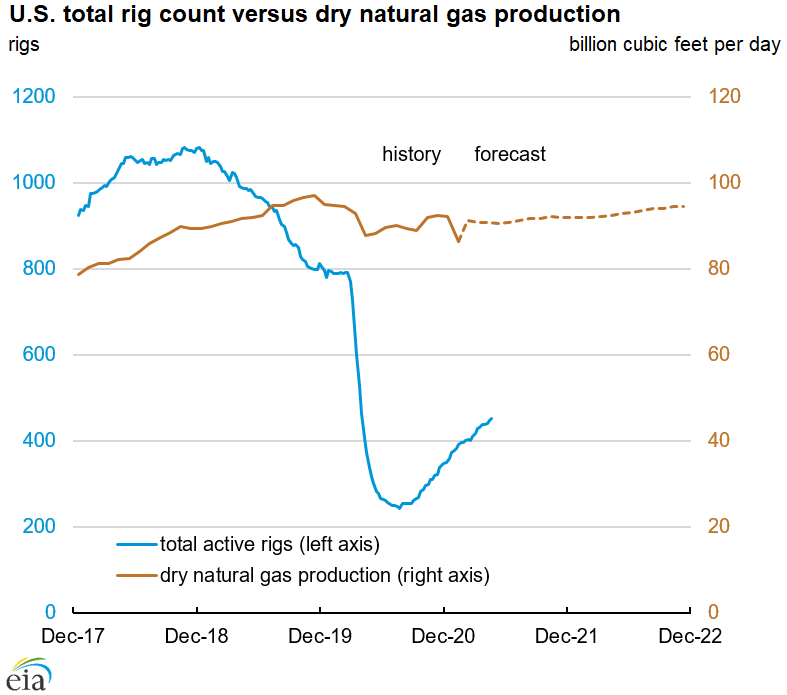 Source: Graph by EIA, based on data from Baker Hughes Company (rig count) and EIA's Natural Gas Monthly and Short-Term Energy Outlook (production).
Source: Graph by EIA, based on data from Baker Hughes Company (rig count) and EIA's Natural Gas Monthly and Short-Term Energy Outlook (production).Note: The solid orange line is Natural Gas Monthly data and the dashed orange line is the Short-Term Energy Outlook forecast.
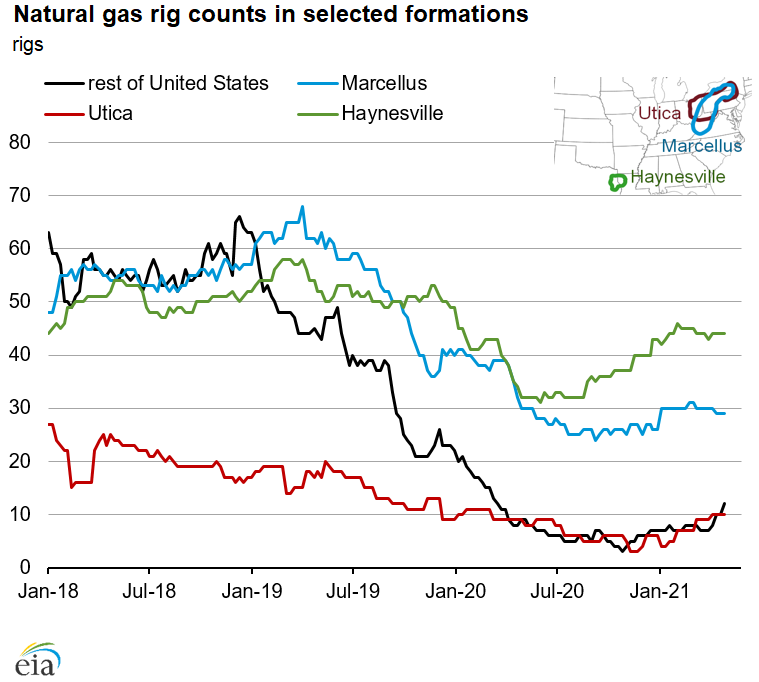 Source: Graph by EIA, based on data from Baker Hughes Company
Source: Graph by EIA, based on data from Baker Hughes Company
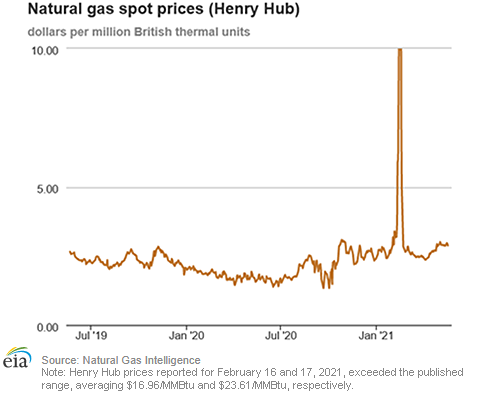
| Spot Prices ($/MMBtu) | Thu, 13-May |
Fri, 14-May |
Mon, 17-May |
Tue, 18-May |
Wed, 19-May |
|---|---|---|---|---|---|
| Henry Hub |
2.87 |
2.87 |
2.97 |
2.94 |
2.88 |
| New York |
2.16 |
2.20 |
2.58 |
2.55 |
2.48 |
| Chicago |
2.76 |
2.70 |
2.87 |
2.87 |
2.80 |
| Cal. Comp. Avg.* |
3.34 |
3.11 |
3.32 |
3.31 |
3.24 |
| Futures ($/MMBtu) | |||||
| June contract | 2.973 |
2.961 |
3.109 |
3.012 |
2.964 |
| July contract |
3.025 |
3.018 |
3.164 |
3.078 |
3.028 |
| *Avg. of NGI's reported prices for: Malin, PG&E Citygate, and Southern California Border Avg. | |||||
| Source: NGI's Daily Gas Price Index | |||||
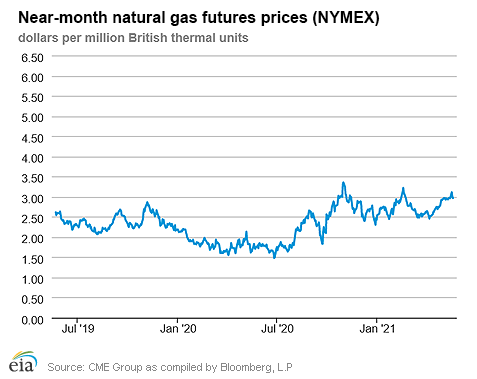
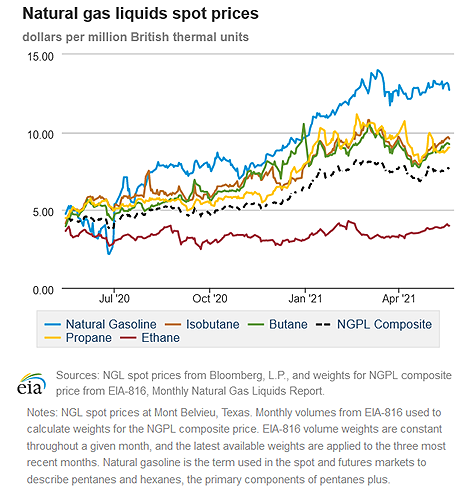
| U.S. natural gas supply - Gas Week: (5/13/21 - 5/19/21) | |||
|---|---|---|---|
Average daily values (Bcf/d): |
|||
this week |
last week |
last year |
|
| Marketed production | 103.9 |
103.9 |
97.1 |
| Dry production | 91.8 |
91.8 |
86.9 |
| Net Canada imports | 4.5 |
4.8 |
3.8 |
| LNG pipeline deliveries | 0.1 |
0.1 |
0.1 |
| Total supply | 96.4 |
96.7 |
90.8 |
|
Source: IHS Markit | |||
| U.S. natural gas consumption - Gas Week: (5/13/21 - 5/19/21) | |||
|---|---|---|---|
Average daily values (Bcf/d): |
|||
this week |
last week |
last year |
|
| U.S. consumption | 58.2 |
65.3 |
59.2 |
| Power | 26.4 |
26.0 |
26.4 |
| Industrial | 21.4 |
22.0 |
20.1 |
| Residential/commercial | 10.4 |
17.3 |
12.7 |
| Mexico exports | 6.1 |
6.2 |
4.5 |
| Pipeline fuel use/losses | 6.1 |
6.2 |
5.9 |
| LNG pipeline receipts | 10.3 |
11.2 |
6.3 |
| Total demand | 80.6 |
89.0 |
75.9 |
|
Source: IHS Markit | |||
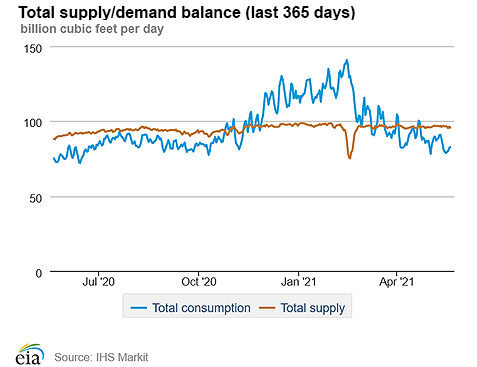
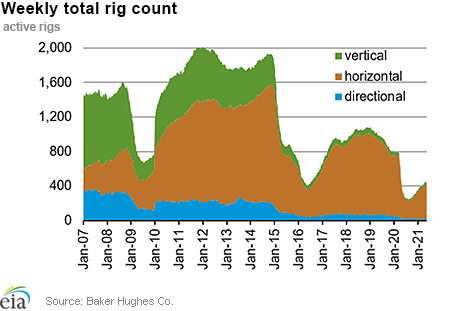
| Rigs | |||
|---|---|---|---|
Tue, May 11, 2021 |
Change from |
||
last week |
last year |
||
| Oil rigs | 352 |
2.3% |
36.4% |
| Natural gas rigs | 100 |
-2.9% |
26.6% |
| Note: Excludes any miscellaneous rigs | |||
| Rig numbers by type | |||
|---|---|---|---|
Tue, May 11, 2021 |
Change from |
||
last week |
last year |
||
| Vertical | 15 |
-11.8% |
50.0% |
| Horizontal | 410 |
0.5% |
33.6% |
| Directional | 28 |
21.7% |
27.3% |
| Source: Baker Hughes Co. | |||
| Working gas in underground storage | ||||
|---|---|---|---|---|
Stocks billion cubic feet (Bcf) |
||||
| Region | 2021-05-14 |
2021-05-07 |
change |
|
| East | 358 |
347 |
11 |
|
| Midwest | 472 |
458 |
14 |
|
| Mountain | 135 |
131 |
4 |
|
| Pacific | 247 |
235 |
12 |
|
| South Central | 888 |
857 |
31 |
|
| Total | 2,100 |
2,029 |
71 |
|
| Source: Form EIA-912, Weekly Underground Natural Gas Storage Report | ||||
| Working gas in underground storage | |||||
|---|---|---|---|---|---|
Historical comparisons |
|||||
Year ago (5/14/20) |
5-year average (2016-2020) |
||||
| Region | Stocks (Bcf) |
% change |
Stocks (Bcf) |
% change |
|
| East | 467 |
-23.3 |
392 |
-8.7 |
|
| Midwest | 573 |
-17.6 |
471 |
0.2 |
|
| Mountain | 123 |
9.8 |
128 |
5.5 |
|
| Pacific | 251 |
-1.6 |
236 |
4.7 |
|
| South Central | 1,078 |
-17.6 |
959 |
-7.4 |
|
| Total | 2,491 |
-15.7 |
2,187 |
-4.0 |
|
| Source: Form EIA-912, Weekly Underground Natural Gas Storage Report | |||||
| Temperature – heating & cooling degree days (week ending May 13) | ||||||||
|---|---|---|---|---|---|---|---|---|
HDD deviation from: |
CDD deviation from: |
|||||||
| Region | HDD Current |
normal |
last year |
CDD Current |
normal |
last year |
||
| New England | 88 |
14 |
-41 |
0 |
0 |
0 |
||
| Middle Atlantic | 94 |
35 |
-33 |
0 |
-2 |
0 |
||
| E N Central | 121 |
56 |
-13 |
0 |
-7 |
0 |
||
| W N Central | 99 |
42 |
-26 |
0 |
-9 |
0 |
||
| South Atlantic | 50 |
26 |
-29 |
32 |
-1 |
12 |
||
| E S Central | 46 |
24 |
-32 |
11 |
-12 |
8 |
||
| W S Central | 15 |
9 |
-5 |
41 |
-7 |
9 |
||
| Mountain | 74 |
4 |
9 |
19 |
3 |
-11 |
||
| Pacific | 20 |
-23 |
5 |
2 |
-4 |
-12 |
||
| United States | 72 |
23 |
-15 |
13 |
-3 |
1 |
||
|
Note: HDD = heating degree day; CDD = cooling degree day Source: National Oceanic and Atmospheric Administration | ||||||||
Average temperature (°F)
7-day mean ending May 13, 2021
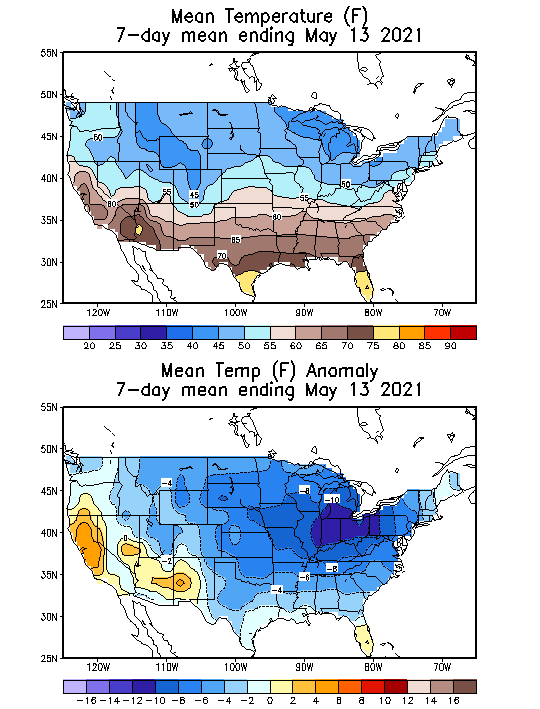
Source: National Oceanic and Atmospheric Administration
Deviation between average and normal (°F)
7-day mean ending May 13, 2021

Source: National Oceanic and Atmospheric Administration

